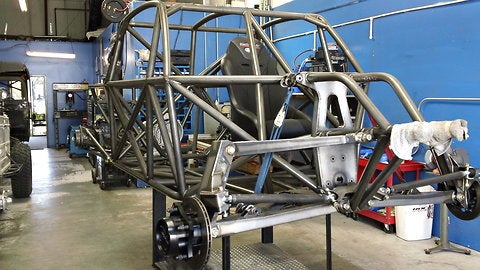
In its 44-year history, the Baja 1000 off-road race has been about speed, sand and full throttle. This coming November, the legendary race will also be about instant torque and low or zero emissions — at least, for some of the drivers. A new vehicle class, , will allow electric and hybrid rigs into the fold this year for the first time. AndĚýJeffrey Smith, an experienced Baja racer, is hoping to win the new class with a fully electric vehicle, reports blog.
Smith has assembled a team of EV experts to design a vehicle with 400 horsepower and 600 pound-feet of torque. The chassis was made by . The drivetrain is the handiwork of EV West, which built an EV racer for the Pikes Peak International Hill Climb, a 12-mile course with 4,700 feet of elevation gain. EVs perform well on this course, compared to gas-powered vehicles, which begin to struggle in the thin air of the 14,110-foot peak.Ěý
So what does all this mean to you? It means that some day, the rumble and the smell of dirt bikesĚýon your favorite mountain bike trail will be replaced by the whirl of electric motors.
If Smith's rig performs well at the Baja 1000, wrote the Times' Jim Motavalli, it could embolden his “goal of electrifying off-road recreation.” Ěý
Said Smith: “In Southern California there are 20,000 dune buggies and other off-road vehicles that people take out to the desert on weekends. They run on internal-combustion engines now, but we want to put electric motors in them.”
Of course, Smith is referring here to off-road vehicle designated areas. But certainly there will be bleed-over onto multi-use trails. And though the noise and smell of gas-powered ORVs will be gone, the dusty plumes and the relatively deeper ruts in the trails will remain.
One could argue that, absent the roar of the engine that signals their approach, sharing trails with electric dirtbikes and other ORVs will add a new element of danger. One could also agrue that electric ORVs will be really, really fun to drive.
And, as I noted in this story about the the many benefitial uses of electric snowmobiles, there are applications for which electric ORVs could be ideally suited (once they've proven to be reliable). Field research. Resort use. How about a EV shuttle (instead of a gas-powered vehicle) to the top of your favorite mountain bike trail? How about an EV Safari?
The possibilities abound, but so do questions about how environmentally sound and wilderness-appropriate these machines might be. Let us know what you think.Ěý
–Mary Catherine O'Connor
Ěý